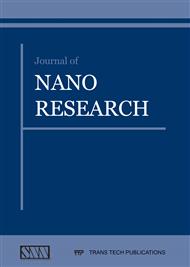[1]
Quibell J.E., Excavation at Saqqara, le caire Imprimerie De L'institute Francais D'archeologie Orientale, le caire, (1907), P. 192-194.
Google Scholar
[2]
Lucas A., Harris J. R., Ancient Egyptian Materials and Industries. Dover Publications. London, (1962), pp.214-220.
Google Scholar
[3]
Merrifield M.M., the art of fresco painting, C Gilpin, London, (1992), 31-35.
Google Scholar
[4]
Ashurst J., Conservation of building & decorative stone, plant a tree, Butterworth, great Britain, (1998), P. 15.
Google Scholar
[5]
Baglioni P., Nanoscience for the conservation of cultural heritage , in removal of damaging conservation treatments on mural paintings a reseach and development report from the work shop, osterbybruk, Sweden, nov. 283, (2007), pp.1-72.
Google Scholar
[6]
Blee A., Martin J.G., Nanoparticles and the conservation of cultural heritage, materials forum, vol. 32, (2008), pp.123-127.
Google Scholar
[7]
Baglioni P., Giorgi R., Chelazzi D., 2012, Nano materials for conservation and preservation of movabal and immovable artworks, progress in cultural heritage preservation– euromed, (2012) pp.313-318.
DOI: 10.1260/2047-4970.1.0.313
Google Scholar
[8]
Carretti E., Dei L., Cleaning I application, chapter 5, in nano science in conservation of work of arts. (2015), p.250.
Google Scholar
[9]
Stuart B.H., Analytical techniques in materials conservation, John Wiley & Sons Ltd, England, (2007), pp.142-144.
Google Scholar
[10]
Natali I, Saladino M. L, Andriulo F., Martino C., Caponetti E., Carretti E., Dei L., Consolidation and protection by nanolime: recent advances for the conservation of the graffiti, Carceri dello Steri Palermo and of the 18th century lunettes, SS. Giuda e Simone Cloister, Corniola (Empoli) Journal of Cultural Heritage 15 , (2014).
DOI: 10.1016/j.culher.2013.03.002
Google Scholar
[11]
Grassi S., Carretti E., Pecorelli P., Iacopini F., Baglioni P., Dei L., The conservation of the Vecchietta's wall paintings in theOld Sacristy of Santa Maria della Scala in Siena: The useof nanotechnological cleaning agents , Journal Of Cultural Heritage, (2007).
DOI: 10.1016/j.culher.2006.10.008
Google Scholar
[12]
Domingues J., Bonelli N., Giorgi R., Fratini E., Gorel F., Baglioni P., Innovative Hydrogels Based on Semi- Interpenetrating p(HEMA)/PVP Networks for the Cleaning of Water-Sensitive Cultural Heritage Artifacts" Langmuir, 29, (2013) P. 715-723.
DOI: 10.1021/la3048664
Google Scholar
[13]
Giorgi R., Baglioni M., Berti D., Baglioni P., New Methodologies for the Conservation of Cultural Heritage, Micellar Solutions, Microemulsions , and Hydroxide Nanoparticles, Account of chemical research, (2009) , PP. 605-704.
DOI: 10.1021/ar900193h
Google Scholar


